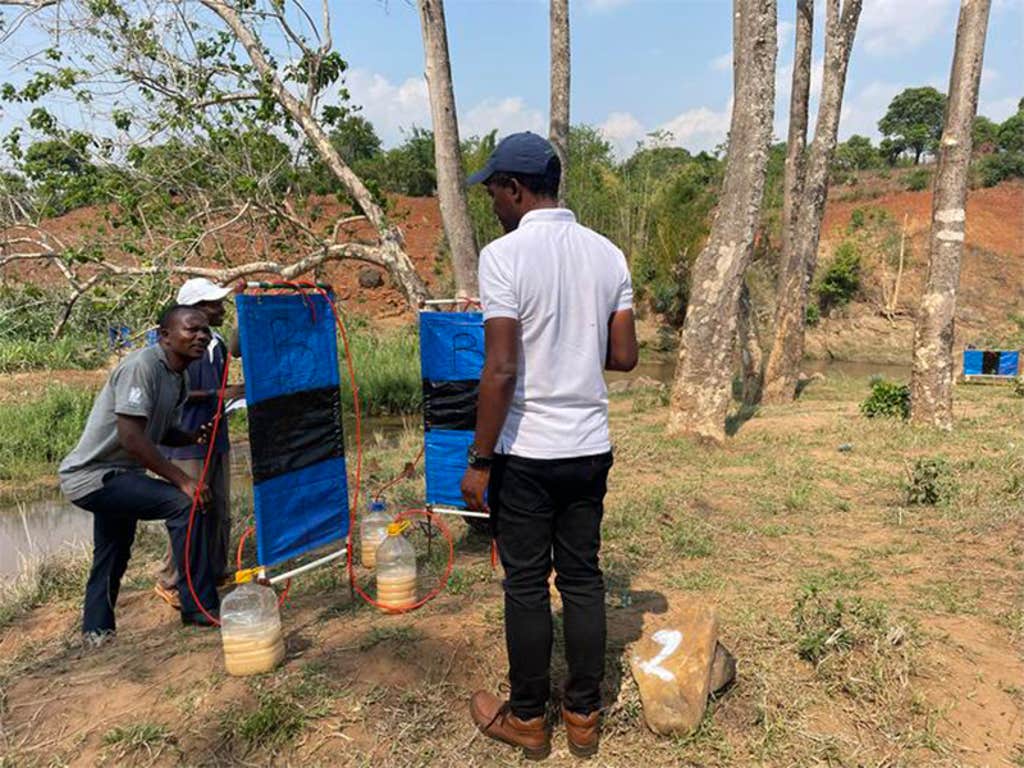More than 250 million people in about 30 countries are at risk of contracting a disease called river blindness, which can result in irreversible loss of vision. But at the moment, the best way to monitor for the disease involves using human volunteers as bait to collect the insects that carry the causative parasites.
River blindness, or onchocerciasis, is caused by the parasitic worm Onchocerca volvulus—when blackflies infected with the worms bite people, they transmit the worm’s larvae. The name river blindness refers to the fact that blackflies breed in quick-moving rivers. Adult worms, which can grow up to nearly 20 inches long, live inside human hosts for up to 15 years and birth millions of baby worms called microfilariae. These can make their way to people’s skin and eyes, leading to painful itching and chronic inflammation. In some cases, microfilariae produce lesions on the eyes that can cause permanent blindness. River blindness is most prevalent in the African continent, Yemen, and parts of Latin America.

While there are no medications or vaccines to prevent river blindness, the drug ivermectin kills microfilariae and can curb the disease’s spread when widely distributed to large populations. To monitor for flies infected with O. volvulus, researchers throughout Africa collect thousands of these insects each year. They do this by asking human volunteers to sit by rivers for hours, where they entice blackflies to land on their skin, capturing the flies with a glass tube—this is the only blackfly collection technique currently recommended by the World Health Organization for such research.
While volunteers receive treatment for river blindness ahead of time as a precaution, the bites can still be painful. And spending long stretches in this environment can increase one’s risk of snake bites or contracting pathogens from other disease vectors, such as tsetse flies and mosquitoes. That’s why Sightsavers, an international charity that works to prevent avoidable blindness, wanted to develop an alternative monitoring method to keep tabs on onchocerciasis-carrying blackflies.
Read more: “The Curse That Shoes Can Break”
“Using people as bait, even if they’ve willingly volunteered, raises big ethical questions,” said Louise Hamill, Sightsavers director for onchocerciasis, in a statement. “We clearly need a better solution.”
Along with the Global Institute for Disease Elimination and the ministries of health in Ghana, Cote d’Ivoire, Malawi, and Mozambique, Sightsavers tested a variety of insect traps to collect blackflies. They gauged the efficacy of 16 different versions of insect traps, known as Esperanza Window Traps, at blackfly breeding sites in Cote d’Ivoire, Malawi, Ghana, and Mozambique, deployed from 2021 to 2025.
These traps incorporated carbon dioxide to imitate human breath—both synthetic and CO2 sourced from yeast—along with different colors, sizes, shapes, and odors. In some traps, the team placed worn socks—the smell of human sweat lures in blackflies. To other traps, they added faux foot stink.
Ultimately, the ideal setup varied by location. For example, in Côte d’Ivoire and Mozambique, where the number of flies was relatively low, traps with yeast-derived carbon dioxide and worn socks were most effective. But in Malawi and Ghana, where flies swarmed, both sources of carbon dioxide and both real and fake sock scents worked equally well.
Overall, the researchers found that seven pairs of these traps could work as well as one human flycatcher. “The traps are easy to set up and require minimal maintenance in the field,” Sightsavers noted in a report. A spokesperson from the organization says via email that the final results won’t be published until next year, but the research culminated in a standardized data collection guide for local officials to keep tabs on the spread of river blindness.
The project also resulted in a tool to predict the locations of blackfly breeding sites, using satellite data and machine learning, to cut down on the time people spend hunting down blackflies by rivers and putting themselves at risk of disease. The model reached 83.1 percent accuracy, “indicating excellent predictive performance,” suggesting that it can target surveillance to specific areas.
Researchers also noted that the traps can catch other insects that act as vectors of human disease, which may help communities monitor multiple pathogens simultaneously.
Plus, the traps can help curtail blackfly populations by snapping up females before they can lay eggs. “This has potential to offer communities long-term protection from river blindness,” the statement said. ![]()
Enjoying Nautilus? Subscribe to our free newsletter.
Lead image: badnews86dups / Shutterstock
































